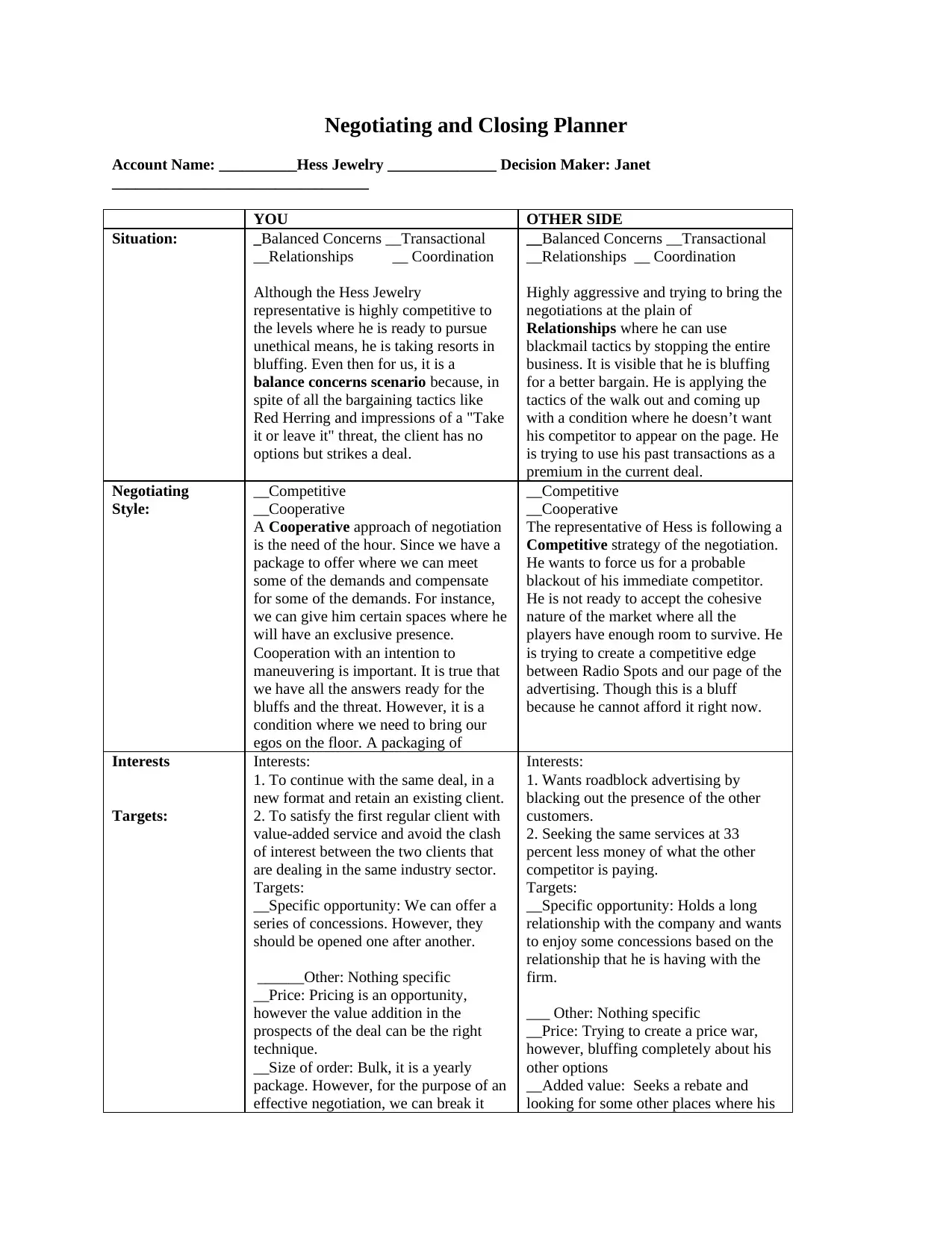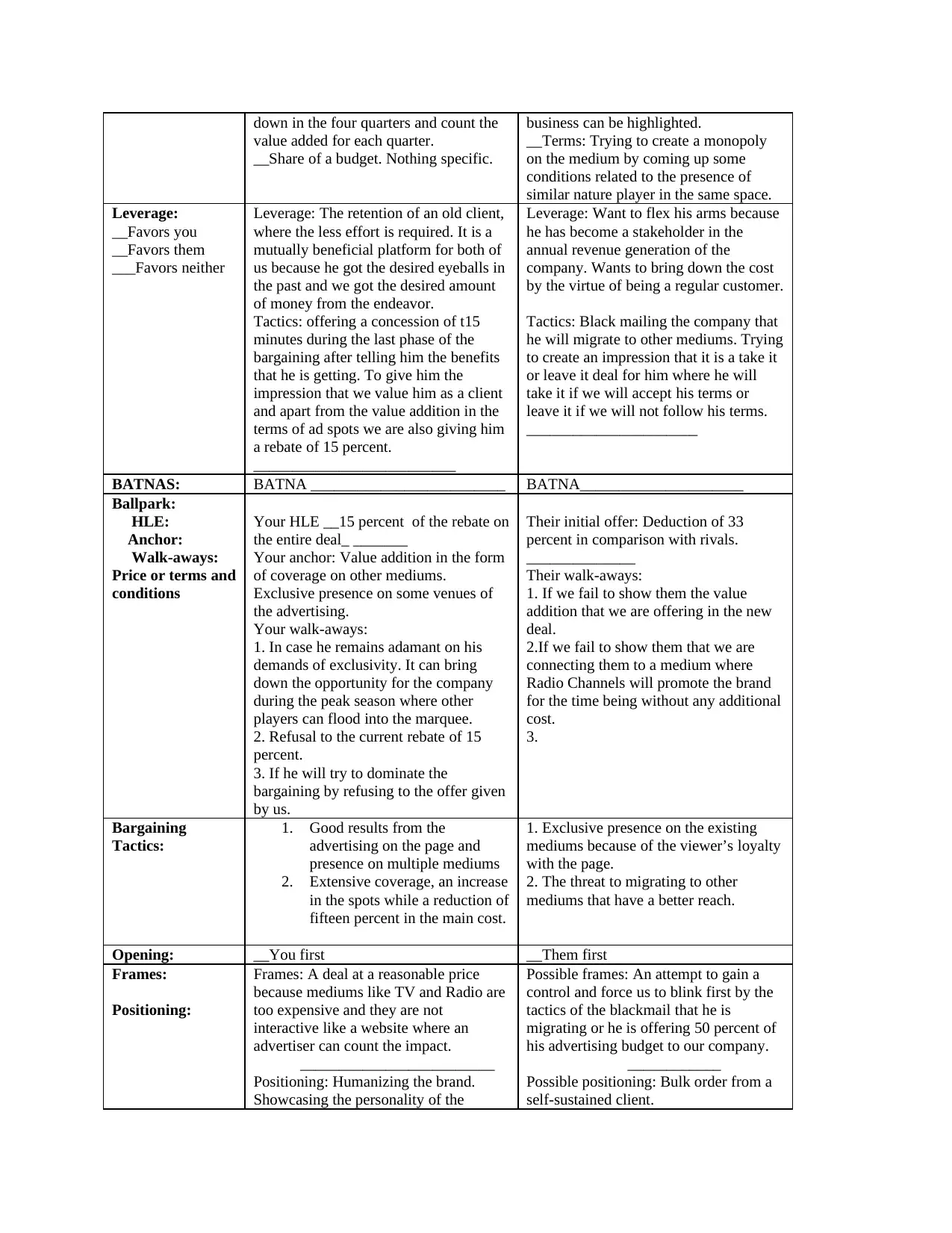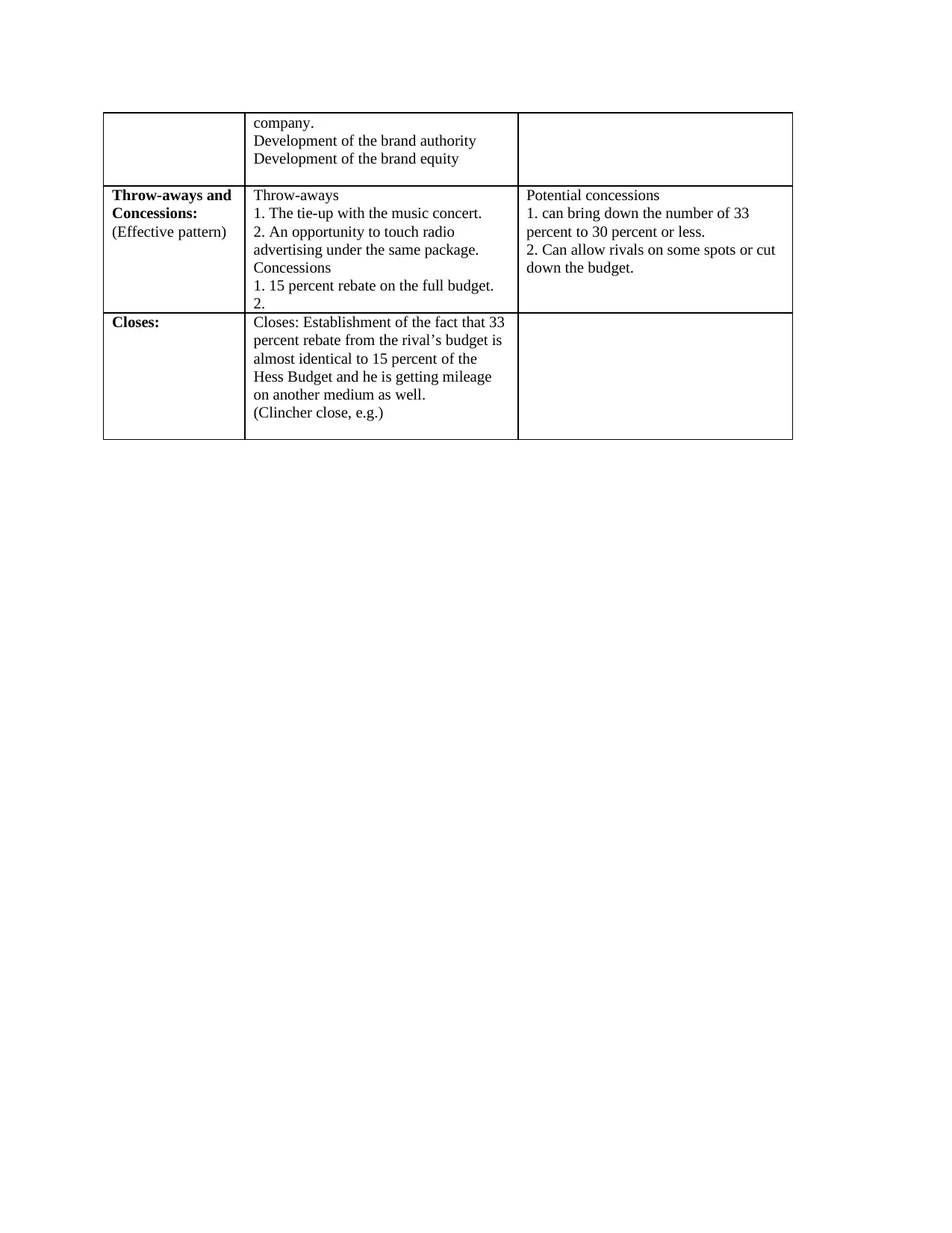Analyzing Negotiation and Closing Strategies for Hess Jewelry Account
VerifiedAdded on 2023/06/04
|3
|1368
|325
Homework Assignment
AI Summary
This assignment presents a detailed negotiation and closing planner for the Hess Jewelry account, focusing on a salesperson's approach with the DailyNews.com. It outlines the situation, negotiating styles, and the interests and targets of both parties. The planner assesses leverage, BATNAs (Best Alternative to a Negotiated Agreement), and bargaining tactics, including opening moves, framing, and positioning. It also includes throw-aways, concessions, and closing strategies. The analysis highlights the competitive nature of the Hess Jewelry representative, who employs tactics like bluffing and attempting to create a monopoly. The assignment emphasizes the importance of a cooperative approach while managing the client's demands for exclusivity and discounts. The planner also details the DailyNews.com's approach, including value-added services, concessions, and strategies to counter the client's tactics, all aimed at retaining the client and securing a beneficial deal.

Negotiating and Closing Planner
Account Name: __________Hess Jewelry ______________ Decision Maker: Janet
_________________________________
YOU OTHER SIDE
Situation: _Balanced Concerns __Transactional
__Relationships __ Coordination
Although the Hess Jewelry
representative is highly competitive to
the levels where he is ready to pursue
unethical means, he is taking resorts in
bluffing. Even then for us, it is a
balance concerns scenario because, in
spite of all the bargaining tactics like
Red Herring and impressions of a "Take
it or leave it" threat, the client has no
options but strikes a deal.
__Balanced Concerns __Transactional
__Relationships __ Coordination
Highly aggressive and trying to bring the
negotiations at the plain of
Relationships where he can use
blackmail tactics by stopping the entire
business. It is visible that he is bluffing
for a better bargain. He is applying the
tactics of the walk out and coming up
with a condition where he doesn’t want
his competitor to appear on the page. He
is trying to use his past transactions as a
premium in the current deal.
Negotiating
Style:
__Competitive
__Cooperative
A Cooperative approach of negotiation
is the need of the hour. Since we have a
package to offer where we can meet
some of the demands and compensate
for some of the demands. For instance,
we can give him certain spaces where he
will have an exclusive presence.
Cooperation with an intention to
maneuvering is important. It is true that
we have all the answers ready for the
bluffs and the threat. However, it is a
condition where we need to bring our
egos on the floor. A packaging of
__Competitive
__Cooperative
The representative of Hess is following a
Competitive strategy of the negotiation.
He wants to force us for a probable
blackout of his immediate competitor.
He is not ready to accept the cohesive
nature of the market where all the
players have enough room to survive. He
is trying to create a competitive edge
between Radio Spots and our page of the
advertising. Though this is a bluff
because he cannot afford it right now.
Interests
Targets:
Interests:
1. To continue with the same deal, in a
new format and retain an existing client.
2. To satisfy the first regular client with
value-added service and avoid the clash
of interest between the two clients that
are dealing in the same industry sector.
Targets:
__Specific opportunity: We can offer a
series of concessions. However, they
should be opened one after another.
______Other: Nothing specific
__Price: Pricing is an opportunity,
however the value addition in the
prospects of the deal can be the right
technique.
__Size of order: Bulk, it is a yearly
package. However, for the purpose of an
effective negotiation, we can break it
Interests:
1. Wants roadblock advertising by
blacking out the presence of the other
customers.
2. Seeking the same services at 33
percent less money of what the other
competitor is paying.
Targets:
__Specific opportunity: Holds a long
relationship with the company and wants
to enjoy some concessions based on the
relationship that he is having with the
firm.
___ Other: Nothing specific
__Price: Trying to create a price war,
however, bluffing completely about his
other options
__Added value: Seeks a rebate and
looking for some other places where his
Account Name: __________Hess Jewelry ______________ Decision Maker: Janet
_________________________________
YOU OTHER SIDE
Situation: _Balanced Concerns __Transactional
__Relationships __ Coordination
Although the Hess Jewelry
representative is highly competitive to
the levels where he is ready to pursue
unethical means, he is taking resorts in
bluffing. Even then for us, it is a
balance concerns scenario because, in
spite of all the bargaining tactics like
Red Herring and impressions of a "Take
it or leave it" threat, the client has no
options but strikes a deal.
__Balanced Concerns __Transactional
__Relationships __ Coordination
Highly aggressive and trying to bring the
negotiations at the plain of
Relationships where he can use
blackmail tactics by stopping the entire
business. It is visible that he is bluffing
for a better bargain. He is applying the
tactics of the walk out and coming up
with a condition where he doesn’t want
his competitor to appear on the page. He
is trying to use his past transactions as a
premium in the current deal.
Negotiating
Style:
__Competitive
__Cooperative
A Cooperative approach of negotiation
is the need of the hour. Since we have a
package to offer where we can meet
some of the demands and compensate
for some of the demands. For instance,
we can give him certain spaces where he
will have an exclusive presence.
Cooperation with an intention to
maneuvering is important. It is true that
we have all the answers ready for the
bluffs and the threat. However, it is a
condition where we need to bring our
egos on the floor. A packaging of
__Competitive
__Cooperative
The representative of Hess is following a
Competitive strategy of the negotiation.
He wants to force us for a probable
blackout of his immediate competitor.
He is not ready to accept the cohesive
nature of the market where all the
players have enough room to survive. He
is trying to create a competitive edge
between Radio Spots and our page of the
advertising. Though this is a bluff
because he cannot afford it right now.
Interests
Targets:
Interests:
1. To continue with the same deal, in a
new format and retain an existing client.
2. To satisfy the first regular client with
value-added service and avoid the clash
of interest between the two clients that
are dealing in the same industry sector.
Targets:
__Specific opportunity: We can offer a
series of concessions. However, they
should be opened one after another.
______Other: Nothing specific
__Price: Pricing is an opportunity,
however the value addition in the
prospects of the deal can be the right
technique.
__Size of order: Bulk, it is a yearly
package. However, for the purpose of an
effective negotiation, we can break it
Interests:
1. Wants roadblock advertising by
blacking out the presence of the other
customers.
2. Seeking the same services at 33
percent less money of what the other
competitor is paying.
Targets:
__Specific opportunity: Holds a long
relationship with the company and wants
to enjoy some concessions based on the
relationship that he is having with the
firm.
___ Other: Nothing specific
__Price: Trying to create a price war,
however, bluffing completely about his
other options
__Added value: Seeks a rebate and
looking for some other places where his
Paraphrase This Document
Need a fresh take? Get an instant paraphrase of this document with our AI Paraphraser

down in the four quarters and count the
value added for each quarter.
__Share of a budget. Nothing specific.
business can be highlighted.
__Terms: Trying to create a monopoly
on the medium by coming up some
conditions related to the presence of
similar nature player in the same space.
Leverage:
__Favors you
__Favors them
___Favors neither
Leverage: The retention of an old client,
where the less effort is required. It is a
mutually beneficial platform for both of
us because he got the desired eyeballs in
the past and we got the desired amount
of money from the endeavor.
Tactics: offering a concession of t15
minutes during the last phase of the
bargaining after telling him the benefits
that he is getting. To give him the
impression that we value him as a client
and apart from the value addition in the
terms of ad spots we are also giving him
a rebate of 15 percent.
__________________________
Leverage: Want to flex his arms because
he has become a stakeholder in the
annual revenue generation of the
company. Wants to bring down the cost
by the virtue of being a regular customer.
Tactics: Black mailing the company that
he will migrate to other mediums. Trying
to create an impression that it is a take it
or leave it deal for him where he will
take it if we will accept his terms or
leave it if we will not follow his terms.
______________________
BATNAS: BATNA _________________________ BATNA_____________________
Ballpark:
HLE:
Anchor:
Walk-aways:
Price or terms and
conditions
Your HLE __15 percent of the rebate on
the entire deal_ _______
Your anchor: Value addition in the form
of coverage on other mediums.
Exclusive presence on some venues of
the advertising.
Your walk-aways:
1. In case he remains adamant on his
demands of exclusivity. It can bring
down the opportunity for the company
during the peak season where other
players can flood into the marquee.
2. Refusal to the current rebate of 15
percent.
3. If he will try to dominate the
bargaining by refusing to the offer given
by us.
Their initial offer: Deduction of 33
percent in comparison with rivals.
______________
Their walk-aways:
1. If we fail to show them the value
addition that we are offering in the new
deal.
2.If we fail to show them that we are
connecting them to a medium where
Radio Channels will promote the brand
for the time being without any additional
cost.
3.
Bargaining
Tactics:
1. Good results from the
advertising on the page and
presence on multiple mediums
2. Extensive coverage, an increase
in the spots while a reduction of
fifteen percent in the main cost.
1. Exclusive presence on the existing
mediums because of the viewer’s loyalty
with the page.
2. The threat to migrating to other
mediums that have a better reach.
Opening: __You first __Them first
Frames:
Positioning:
Frames: A deal at a reasonable price
because mediums like TV and Radio are
too expensive and they are not
interactive like a website where an
advertiser can count the impact.
_________________________
Positioning: Humanizing the brand.
Showcasing the personality of the
Possible frames: An attempt to gain a
control and force us to blink first by the
tactics of the blackmail that he is
migrating or he is offering 50 percent of
his advertising budget to our company.
____________
Possible positioning: Bulk order from a
self-sustained client.
value added for each quarter.
__Share of a budget. Nothing specific.
business can be highlighted.
__Terms: Trying to create a monopoly
on the medium by coming up some
conditions related to the presence of
similar nature player in the same space.
Leverage:
__Favors you
__Favors them
___Favors neither
Leverage: The retention of an old client,
where the less effort is required. It is a
mutually beneficial platform for both of
us because he got the desired eyeballs in
the past and we got the desired amount
of money from the endeavor.
Tactics: offering a concession of t15
minutes during the last phase of the
bargaining after telling him the benefits
that he is getting. To give him the
impression that we value him as a client
and apart from the value addition in the
terms of ad spots we are also giving him
a rebate of 15 percent.
__________________________
Leverage: Want to flex his arms because
he has become a stakeholder in the
annual revenue generation of the
company. Wants to bring down the cost
by the virtue of being a regular customer.
Tactics: Black mailing the company that
he will migrate to other mediums. Trying
to create an impression that it is a take it
or leave it deal for him where he will
take it if we will accept his terms or
leave it if we will not follow his terms.
______________________
BATNAS: BATNA _________________________ BATNA_____________________
Ballpark:
HLE:
Anchor:
Walk-aways:
Price or terms and
conditions
Your HLE __15 percent of the rebate on
the entire deal_ _______
Your anchor: Value addition in the form
of coverage on other mediums.
Exclusive presence on some venues of
the advertising.
Your walk-aways:
1. In case he remains adamant on his
demands of exclusivity. It can bring
down the opportunity for the company
during the peak season where other
players can flood into the marquee.
2. Refusal to the current rebate of 15
percent.
3. If he will try to dominate the
bargaining by refusing to the offer given
by us.
Their initial offer: Deduction of 33
percent in comparison with rivals.
______________
Their walk-aways:
1. If we fail to show them the value
addition that we are offering in the new
deal.
2.If we fail to show them that we are
connecting them to a medium where
Radio Channels will promote the brand
for the time being without any additional
cost.
3.
Bargaining
Tactics:
1. Good results from the
advertising on the page and
presence on multiple mediums
2. Extensive coverage, an increase
in the spots while a reduction of
fifteen percent in the main cost.
1. Exclusive presence on the existing
mediums because of the viewer’s loyalty
with the page.
2. The threat to migrating to other
mediums that have a better reach.
Opening: __You first __Them first
Frames:
Positioning:
Frames: A deal at a reasonable price
because mediums like TV and Radio are
too expensive and they are not
interactive like a website where an
advertiser can count the impact.
_________________________
Positioning: Humanizing the brand.
Showcasing the personality of the
Possible frames: An attempt to gain a
control and force us to blink first by the
tactics of the blackmail that he is
migrating or he is offering 50 percent of
his advertising budget to our company.
____________
Possible positioning: Bulk order from a
self-sustained client.

company.
Development of the brand authority
Development of the brand equity
Throw-aways and
Concessions:
(Effective pattern)
Throw-aways
1. The tie-up with the music concert.
2. An opportunity to touch radio
advertising under the same package.
Concessions
1. 15 percent rebate on the full budget.
2.
Potential concessions
1. can bring down the number of 33
percent to 30 percent or less.
2. Can allow rivals on some spots or cut
down the budget.
Closes: Closes: Establishment of the fact that 33
percent rebate from the rival’s budget is
almost identical to 15 percent of the
Hess Budget and he is getting mileage
on another medium as well.
(Clincher close, e.g.)
Development of the brand authority
Development of the brand equity
Throw-aways and
Concessions:
(Effective pattern)
Throw-aways
1. The tie-up with the music concert.
2. An opportunity to touch radio
advertising under the same package.
Concessions
1. 15 percent rebate on the full budget.
2.
Potential concessions
1. can bring down the number of 33
percent to 30 percent or less.
2. Can allow rivals on some spots or cut
down the budget.
Closes: Closes: Establishment of the fact that 33
percent rebate from the rival’s budget is
almost identical to 15 percent of the
Hess Budget and he is getting mileage
on another medium as well.
(Clincher close, e.g.)
⊘ This is a preview!⊘
Do you want full access?
Subscribe today to unlock all pages.

Trusted by 1+ million students worldwide
1 out of 3
Your All-in-One AI-Powered Toolkit for Academic Success.
+13062052269
info@desklib.com
Available 24*7 on WhatsApp / Email
![[object Object]](/_next/static/media/star-bottom.7253800d.svg)
Unlock your academic potential
Copyright © 2020–2025 A2Z Services. All Rights Reserved. Developed and managed by ZUCOL.


